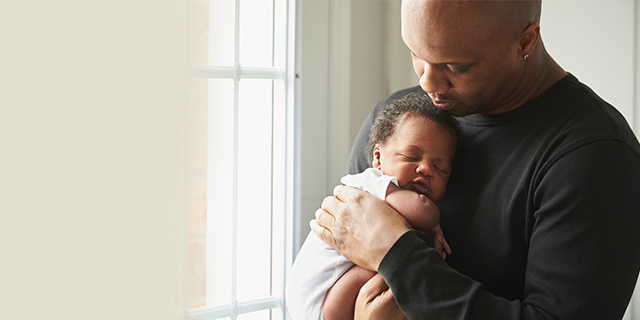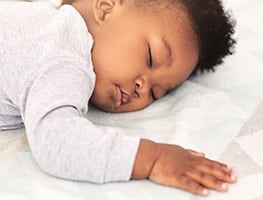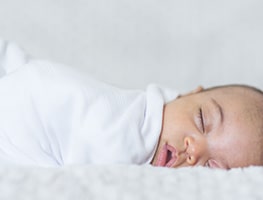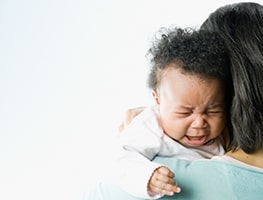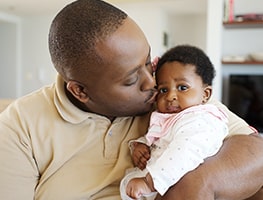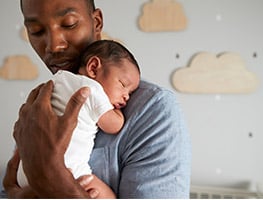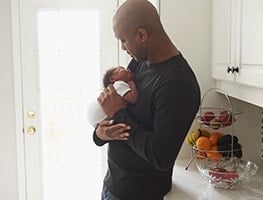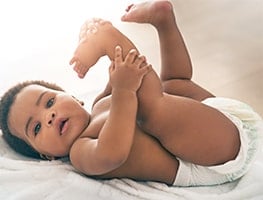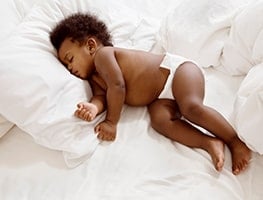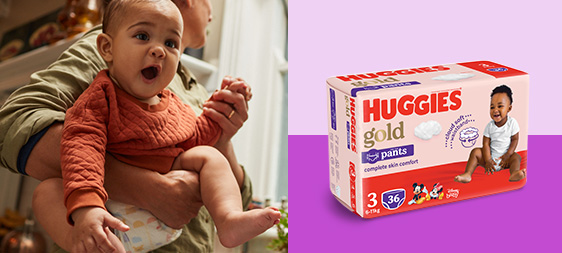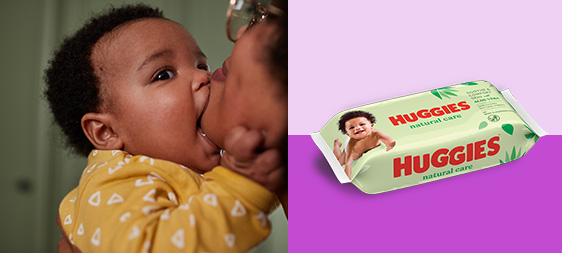Young babies normally respond with a startle or fright when there is a sudden noise, or a change in the way they are held. One of their primitive reflexes, known as the Moro reflex, causes them to react this way, particularly when they feel insecure – it is very normal behaviour for a baby, and will disappear after about 3-4 months.
However, startling in response to a scary situation or being able to feel fear doesn’t occur until they are mature enough to perceive that there could be danger, and when they are capable of anticipating it. Experts think babies start to form a concept of fear from around 6 months onwards. Separation anxiety is common for babies, causing them to become upset when the people they have formed primary attachments to aren’t close by. This is one of the earliest, most primal, of fears.
The first year of a baby’s life is a time of enormous change and maturity. One of the primary tasks in their emotional development is to form loving, close and trusting relationships with their parents. Staying close to those they know well, and who provide them with food, warmth and shelter is a survival mechanism and essential for life.
What is the difference between a fear and a phobia?
Fear is a healthy emotion. It is strongly connected with our safety and well-being, and protects us from potentially harmful situations. It is also dependent on personality and temperament, and is highly variable between each of us.
A phobia occurs when fear becomes irrational or intense, causing the person to feel an overwhelming feeling of anxiety. Individuals who have phobias suffer greatly, because their ability to enjoy everyday life is impacted by the “what if’s”. It is rare for small children to develop such high levels of anxiety that they actually require treatment.
What causes children to have fears and phobias?
There is thought to be a genetic component to the inheritance of fear and anxiety traits, and role-modelling from parents contributes as well. Children learn socialisation skills from their parents and families. Those children, who frequently witness a parent’s moods escalating in reaction to a stressful or fearful event, learn that this is an appropriate response. Although phobias themselves aren’t inherited, a parent’s behaviours and anxious responses can be quickly learnt.
Some children just seem to be born more fearful and imaginative than others. They are naturally cautious, and hold back in situations until they feel confident enough to venture out and gauge situations for themselves. They need to be parented gently, with lots of reassurance and explanation for what is happening. Anxious kids want lots of explanations. They don’t thrive on unpredictability and like routine and order.
Other children seem to have more of a risk-taking nature; they are more naturally curious and don’t let fear restrain them from where they want to go and what they want to see. These kids can be equally hard to parent. The potential that they will do themselves harm is higher, and they don’t seem to have a healthy respect for what could go wrong.
Common fears in babies
Sudden household noises coming from kitchen appliances like food processors, vacuum cleaners, a flushing toilet, or the dishwasher emptying. Pulling the plug out of the bath can prompt a genuinely frightened reaction from some babies, who probably think they’re about to go down the hole too.
A car engine starting, sirens in the street, planes overhead, or the sound of a particularly heavy storm and thunder.
Being put into the cot and their parent leaving suddenly. Most babies need a time of transition between being in their parent’s arms and going to sleep. Some babies don’t like to be left alone and want their parents close by when they are settling to sleep.
Animals such as dogs and cats, or birds flying overhead. Even a well domesticated animal can move in a sudden or unexpected way, which frightens young children.
A wind-up toy, doors banging, or anything sudden and unexpected.
Many babies get frightened when they are being dressed or dislike being naked, having a shirt pulled over their face, being picked up suddenly, or any sudden movements.
What you can do
Most babies grow out of their early fears without too much intervention from parents.
When settling your baby, be gentle and calm, reassuring and soothing. Babies that feel scared cannot relax enough to go to sleep. They need to feel safe before they allow themselves to “switch off” enough to drift off to sleep.
It will help for you to try and predict your baby’s reaction and avoid their distress if possible. Try not to see their fearfulness as funny or an opportunity for a funny home video.
Avoid ridiculing your baby or trying to prompt a fearful reaction. This can affect their confidence and, over time, teach them that emotions are not something to be taken seriously.
Reassure and comfort your baby. Positive messages that they are okay, you are there and everything is alright, do so much to help a child’s sense of security.
Some children like to have a security blanket or toy close to them. There is no ideal toy, and children often just choose something that has special meaning to them. Using a “transitional love object” is not a sign of emotional immaturity or inadequate attachment to parents.
Empathy from parents is a powerful, nurturing emotion. Babies need to feel this every day, and have the sense that their parents are emotionally in tune with their feelings.
Don’t force your baby to confront what it is that they’re scared of. Exposure therapy is designed for adults or children old enough, who have the benefit of logical thought and reasoning. Babies aren’t really capable of connecting themselves with the outside world until they are closer to 3 years old.
Give your baby space and time. You can help by staying calm and trying not to let their fear rub off onto you.
Common fears in toddlers
One of the skills toddlers develop is how to separate fact from fantasy. Imagination plays a large part in their lives, as fears start to become more concrete and clear. Girls tend to be more fearful than boys, though the reason for this is not entirely clear.
Fear of animals like snakes, frogs, spiders, sharks and lizards.
Fear of aliens, monsters, or demons that may be lurking in shadows or under the bed.
Often, a small event can trigger a series of ongoing fears. Long after the original trauma occurred, the child responds in the same fearful way, because this has become a learned, entrenched behaviour to the trigger.
Some children are scared of natural disasters that they have picked up on from television or news coverage. Storms, house fires, cyclones or floods are a very real fear to many. Also check what cartoons they watch – many of them are very violent and not really suitable for children.
As children get older they may become fearful of something happening to their parents. These little fears often come to light in the quiet pre-bed settling conversations most parents have with their kids. Try not to be drawn into long-winded explanations but keep your answers short and reassuring.
What you can do
Our job as parents is not to insulate our children’s worlds, but to help them learn skills in how to deal with it.
Try not to perceive danger where it is unlikely to exist. Always telling your child to “be careful” or “watch out” encourages them to become hyper vigilant and anxious.
Show them what it means to be confident in new situations. Be cautious, though not fearful yourself unless, of course, the situation demands it.
Praise them when they are being brave and confident. Children thrive on positive reinforcement and descriptions of the behaviour their parents want to see repeated.

